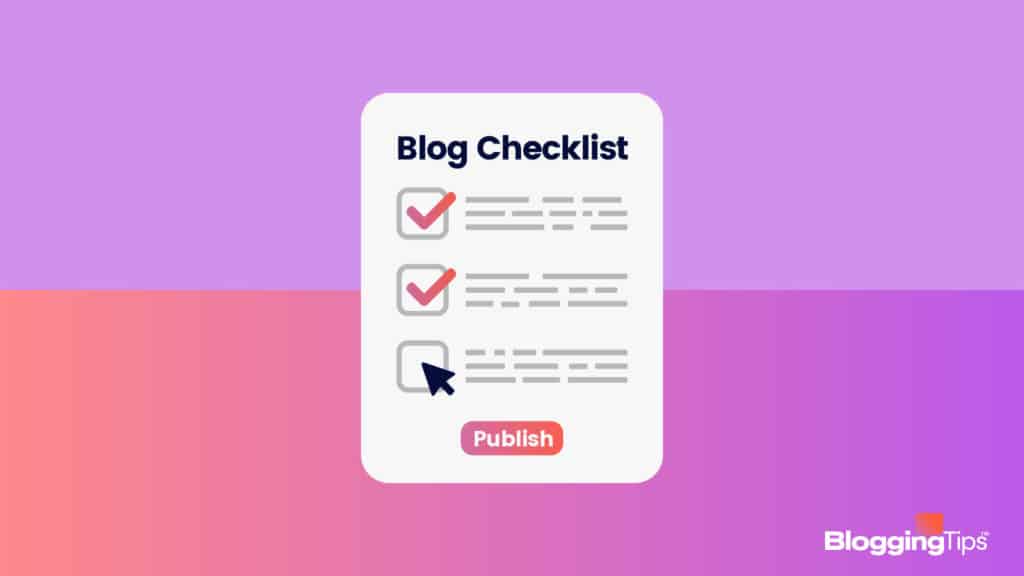So you want to start a blog?
That’s fantastic!
Blogging can be a lot of fun. It can also become a profitable way to share your thoughts, insights, and experiences with the world.
Before you can start blogging, though, there are some basics that you must understand.
In this article, we will teach you how to blog from start to finish.
We’ll cover everything from researching a topic to writing quality content that engages your readers.
We’ll also talk about how to optimize your blog posts for search engines, and how to make money from your blog.
Contents
The Fundamentals of How To Blog
Let’s first review the basics of blogging to help you get a good basis of understanding under your belt.

What Is a Blog?
A blog is a type of website where the content is typically published in reverse chronological order.
It means that the most recent content appears first, and older content gradually moves down the page as you add newer posts.
Most blogs also have a commenting system where readers can leave feedback on individual articles.
What Kind of Blogs Make Money?
There are two main ways that bloggers make money.
Advertising on blogs and blogs that sell products or services makes money.
How Do Bloggers Get Paid?
Advertising is the most common way for bloggers to make money.
You can sell ads on your blog directly, or sign up for an ad network like Google AdSense or Mediavine.
These networks will place relevant ads on your blog and pay you every time someone clicks on an ad.
The other way to make money from your blog is through selling products or services.
It could be anything from digital products like ebooks and online courses, to physical products like jewelry and home decor.
You don’t have to create these products and services either.
Instead, you can become an affiliate for companies that sell products in your niche.
Using affiliate marketing, you will earn a commission every time someone buys something through your link.
Where Should a Beginner Blog?
You might feel confused about where to blog as a beginner.
Should you use a free or paid blogging platform?
Paid Blogs vs. Free Blogs
We’ve written two blog posts that we encourage you to look at regarding starting a blog and the pros and cons of using free blog sites.
Suffice it to say that you should select a paid blogging platform when your goal is making money blogging.
Can I Start a Blog for Free?
Yes, you can start a blog for free using platforms like WordPress.com.
However, if you’d like to make money from your blog, it’s recommended that you use a self-hosted platform like WordPress.org.
How Do I Choose a Blog Name?
Your blog name should be something that represents you and your niche.
For example, if you’re going to blog about recipes, you could use a name like “Cooking with Kate.”
It’s also possible to blog using “yourname.com” as your domain name.
If you’re unsure in this area, you can learn more about how to come up with a blog name.
What Do I Write in a Blog?
You’re in charge when it comes to what you choose to write in a blog post.
However, here are a few guidelines and best practices.
Write content that you know will resonate with your target audience.
You’ll uncover what to write by doing keyword research, looking at what your competitors write about, and using the correct on-page SEO factors.
Deciding what to write and how to lay out each blog post will take a while when you first start.
Ideating a Blog Post
Let’s dig into helping you understand more about choosing the best topic for your blog and its posts.

What Should I Write About?
Feeling confused about what to write about is something we often hear about from new bloggers.
Ideally, it’s a good idea to write content that your target audience actively searches for online.
Many beginner bloggers make the mistake of writing content that very few people search for on Google.
Don’t make this mistake.
If you do, you’ll invest a lot of time writing blog posts and then wonder why your blog fails to reach higher traffic numbers over time.
How do you know what content your future readers search for?
The best way to uncover this information is by conducting keyword research.
Once you understand the keywords your target market uses to find solutions to the problems your writing will solve, you will know exactly what to write about.
Which Topic Is Best for Blogging?
To monetize your blogging efforts, it’s best to select a topic that fits into these three main categories.
- Health
- Personal development
- Wealth
Most humans are willing to buy products and services in these three areas.
They have a good reason to fix problems they encounter regarding their health, wealth, and mindset.
For example, a person suffering from procrastination will seriously consider buying a course or coaching program that fixes the issue.
Or, if someone doesn’t know how to invest their money in the stock market, they will likely spend money on a how-to book or online course.
Anyone dealing with diabetes will probably buy your health supplements that help prevent the problem.
It’s essential to understand this because it means you can make money blogging about any topic as long as there are products and services available for sale in that space.
Trying to monetize a blog in a niche where people don’t spend money is challenging, at best.
At worst, it becomes demoralizing and frustrating after investing months or years writing content.
Researching a Blog Post
Do you have an idea for your first blog post’s topic?
Let’s help you figure out whether you should pursue it.

Validate the Post Idea
You’ve likely heard the phrase, “There’s no such thing as a new idea.”
And this is especially true when it comes to blog posts.
To validate your post idea, do a quick Google search.
If you find several articles on the topic already, that’s usually a good sign.
It means people want to read about it.
If you can’t find any articles, that’s not necessarily a bad sign.
It could mean the topic is too new.
Or, it could be an indicator that no one cares about it.
In this case, do some more research to see if you can find related topics that people want to know more about.
Do Keyword Research
Use a tool like Ubersuggest, Moz’s Keyword Explorer, or the Google Keyword Planner to search for keywords.
These tools help you quickly uncover keywords that relate to your blog post ideas.
When you conduct this research, you’re looking for a few things.
- The keyword’s monthly search volume
- The competition level for the keyword
- Related keywords
If you find a keyword with a high monthly search volume and low competition, that’s usually a good sign.
It means people are searching for the term, but you won’t run into a lot of competing blog posts.
On the other hand, a keyword with a high search volume and high competition could be more difficult to rank for.
But if you can find a related keyword with a high search volume and low competition, that could be a better option to pursue.
For example, let’s say you’d like to write a blog post about how to fix a car engine.
When you conduct your keyword research, you find that the term “car engine repair” has a high monthly search volume but is also quite competitive.
However, you also find that the term “car engine troubleshooting” has a high monthly search volume and low competition.
In this case, consider writing a blog post about car engine troubleshooting.
You’ll have a greater chance to rank for that keyword.
Do Competitor Research
Before you start writing, you should also research your competition.
It will give you an idea of already-existing content and how you can make your blog post stand out.
To do this, Google your selected keyword and take a look at the top results.
As you’re looking through these articles, take note of the following.
- The article’s length
- The tone of voice
- The overall structure
- Any common themes across all the articles
Doing this research will give you a nice idea of how to approach your blog post.
For example, if you find that all the top results are long, in-depth articles, you may want to consider writing a long blog post while adding in more videos, images, and infographics.
If you find that the top results are all short and to the point, you may want to take a similar approach.
The most crucial thing is to make sure your blog post is better than your competition’s.
Make it informative and more engaging.
Don’t pursue the keyword if you don’t think you can make your blog post better than the competition.
Find a different one.
Writing a Blog Post
Now it’s time to become familiar with the blog writing process.

How Do I Just Start Writing?
The best way to start writing a blog post is simply committing to getting started.
Don’t worry about how good or bad your writing is. Just write.
If you get stuck, try these techniques.
- Write the ending first: Doing this can help you stay focused on what you want to achieve with the article.
- Write in bullet points: Use this technique to organize your thoughts and ensure you don’t forget anything important.
- Write in short sentences: It will make your writing more concise and easier to read.
Once you have the first draft, you can start editing and improving it.
But remember, the first step is just getting started.
Stick to a Blog Writing Format
While there are many ways you can format a blog post, sticking to a tried-and-true structure can help make the writing process easier.
It will also ensure your article remains easy to read and digest.
Let’s review a few of the most popular types of blog posts that Google likes to rank.
General Information Posts
A general information post is a common type of blog post.
It’s an article that provides information on a particular topic.
To write a general information post, follow these steps.
- Pick a topic: The best topics are the ones you’re passionate about or have extensive knowledge in.
- Do your research: Once you’ve selected a topic, it’s time to start researching.
Be sure to use reliable sources and take detailed notes. - Organize your thoughts: After gathering the required information, it’s time to start organizing your thoughts. Create an outline of the main points you’re going to cover.
- Start writing: Now it’s time to start putting all your thoughts into words.
Remember to keep your sentences short.
Stay on topic at all times. - Edit and proofread: After writing the post, go back and edit your article.
Make sure there are no grammar or spelling mistakes.
Product Review Posts
A product review post explains all the details about a particular product.
It can be anything from a new gadget to a beauty product.
When writing a product review post, you’ll want to include the following information.
- The pros and cons of the product
- A detailed description of the product
- Your personal experience using it
- How it compares to similar products
- Whether or not you recommend it
X vs. Y Posts
An X vs Y post will compare two similar products, services, or ideas.
For example, you might write a post comparing two different types of camera equipment.
Include the following information when writing X vs Y posts.
- A detailed comparison of the two products
- The pros and cons of each one
- Your personal experience with each one
- State the product you recommend
- Explain why you like your selection
Alternatives Posts
An “alternatives” post provides information on alternative products.
For instance, you could write an “alternatives” post about different types of software for graphic design.
Provide the reader with the following information when writing an “alternatives” post.
- A detailed explanation of each alternative
- The differences between each product
- The similarities between each product
- The pros and cons of individual products
- A bottom line decision on the best choice
Roundup and Listicle Posts
A roundup post is a collection of information from different sources on a particular topic.
If you’re in the website creation space, you might decide to write a roundup post about the best WordPress plugins for bloggers.
You’ll reach out to other bloggers and ask them to provide their thoughts on the topic.
Once you have all the information, compile it into a single article.
Most people enjoy reading the opinions of different industry experts in these types of posts.
Likewise, a listicle post is a list.
For example, listing the best restaurants in a city would be a listicle or list post.
Optimizing a Blog Post
Your job isn’t over after writing the content for a blog post.
It’s crucial to optimize the post if you expect Google to consider it superior to competitor posts.

Add Media to Your Post
Make sure to add infographics, images, or videos to your post.
Not only will this make your post more visually appealing, but it will also help break up large blocks of text.
Most people skim blog posts.
If they see large text blocks, they’re unlikely to stop and read your major sections.
They may continue scrolling to the bottom of your article and then leave the website.
Here’s a tip when placing images on your blog.
Use high-quality images that hold relevance to the topic of your post.
You should also include appropriate keywords in the file names of your images.
For instance, if you’re writing a blog post about how to make a chocolate cake, you might name one of your image files “chocolate-cake-recipe.jpg.”
Add Internal Links to Your Post
Internal links are hyperlinks that point to other pages on your blog.
They help improve the experience on your blog by making it easier for people to find related content.
For instance, if you’re writing a blog post about how to use an excel sheet, you might link to a tutorial video on your blog.
Use this method to keep people on your site longer.
Your visitors will continue down the rabbit hole by visiting multiple pages on your site.
The longer someone spends reading your blog, the higher chance you have that they will convert into a lead or sale.
Including internal links also helps with SEO.
It’s one of many factors Google looks at when ranking a piece of content.
Google wants to see if you’re linking to other relevant content on your blog.
If you are, it signals that your blog is an authoritative source of information.
Add Affiliate Links to Your Post
Affiliate links are hyperlinks that point to products or services on other websites.
When someone clicks on an affiliate link and makes a purchase, you earn a commission from the company you’re affiliated with.
For instance, let’s say you’re a fashion blogger.
You might write a blog post about the best summer dresses.
In that post, you could include affiliate links to the dresses you recommend.
If someone clicks on one of your links and buys a dress, you’ll earn a commission from the company.
Disclose that you’re including affiliate links in your post.
Most readers won’t mind if you’re trying to make a little extra money.
You can let them know that they won’t pay more than the regular price.
Tell that the company pays you the commission for connecting your site visitor to its products.
There are two main ways to find affiliate products to promote.
The first is to join an affiliate network.
You can try ShareASale, ClickBank, or Amazon Associates.
The second is to search for companies that offer affiliate programs on their websites.
Optimize for Readability
No one wants to read a blog post that’s difficult to understand.
Use short sentences and simple words.
Breaking up your content makes it easier to consume, which will keep people on your site longer.
Use headings and subheadings to organize your thoughts.
Using this format makes it easy for readers to find the information they’re looking for.
If they only want to read about a certain topic, they can quickly scan your headings and find the section they’re interested in.
You should focus on using proper grammar and punctuation.
No one will take your blog seriously if it’s full of typos.
Proofread your post before you hit publish.
As well, consider running it through a grammar checker like Grammarly.
Optimize for SEO
You can’t ignore SEO if you want each blog post to rank in Google search results.
Do your research and find high-traffic keywords.
Make sure the keywords match the blog’s topic.
Include those keywords in your post.
However, avoid keyword stuffing.
Google doesn’t like keyword stuffing, and its penalty will affect your SEO.
Use keywords throughout your post, including in the title, headings, and body.
But don’t go overboard.
Partner with related websites to attract backlinks to your blog.
A backlink is when another website links to your blog post.
The more backlinks you have, the higher your blog post will rank in Google search results.
To get started, reach out to websites in your industry and offer to guest post on their site.
Insert a link to your blog post in the author bio section.
As your blog matures, focus on technical SEO methods, too.
Use these behind-the-scenes methods to help your blog post rank higher in Google search results.
Technical SEO includes things like improving your website’s speed.
If your site takes too long to load, people will leave before they even get a chance to read your post.
Promoting a Blog Post
You’ve written a great blog post and optimized it for SEO.
Now it’s time to promote it.

Share on Social Media
The first step is to share your post on different social media platforms.
Post about it on Instagram, Twitter, and LinkedIn.
Share the post with any relevant Facebook groups or LinkedIn groups.
Share to an Email List
If you’re building an email list, send your blog post to your subscribers.
Give them a short introduction to the article in the email to get them interested to click over to your blog.
Becoming a Better Blogger
As you start your blogging journey, always focus on improving your skills.

Ask For Feedback
One way to get better is to ask for feedback from your readers
.Ask them what they like and don’t like about your blog.
What topics are they interested in?
Don’t Get Discouraged at First
It takes time to build an audience.
Don’t get discouraged if you don’t see results right away.
Keep writing quality content and promoting your blog, and you’ll eventually see growth.
Continue writing new content while you’re waiting for the first few blog posts to rank.
Don’t Give Up
Blogging can be a lot of work, but it’s also a lot of fun.
If you find yourself getting burned out, take a break.
But don’t give up altogether.
Take a step back and come back to it when you’re ready.
Don’t Be Afraid to Pivot
Your blog will evolve.
As you learn more about blogging, you may want to change the focus of your blog.
Don’t be afraid to make those changes.
It’s your blog, and you can change it as you see fit.
Make it a point to go back to improve older blog posts when you see them close to ranking on Google’s first page.
Frequently Asked Questions
You may still have questions about how to blog.
Here are the answers to two commonly asked questions from beginner bloggers.

How do blogs get popular?
There is no one answer to this question.
It takes a lot of hard work and dedication to grow a popular blog.
You must produce high-quality content and promote your blog regularly.
Working to gain backlinks is one area most bloggers avoid.
If you want one big tip about getting your blog to become popular, focus on generating a healthy backlink profile.
Google will take notice and start ranking you over your competitors.
What kind of blog is most popular?
It depends on your niche and the type of content you produce.
That said, how-to posts, listicles, and product reviews tend to be popular among readers.
These types of posts are easy to consume and offer value to the reader.
If you can write these types of posts, you’ll likely see success with your blog.
Wrapping Up
Starting a blog can seem like a daunting task, but it doesn’t have to be.
Use this guide as a resource to get started on the right foot.
And remember, Rome wasn’t built in a day.
It takes time and dedication to grow a successful blog.
Produce quality content and promote your blog.
You’ll eventually see the results you’re looking for.
Do you still have additional questions about how to start a blog?
Leave them below in the comments, and we’ll answer them.
If you’re ready to start your blogging journey, use the information we’ve provided to begin today.




